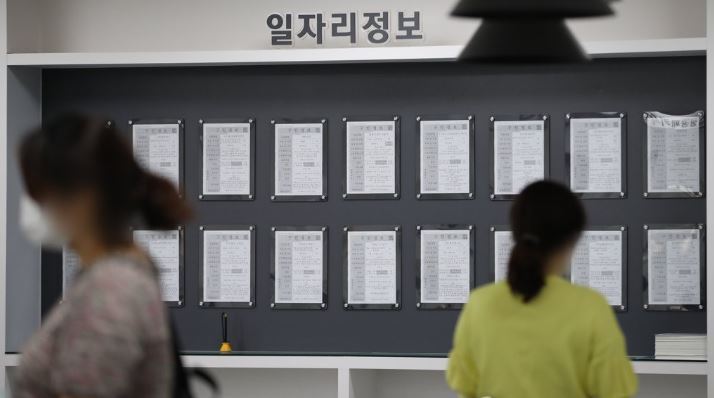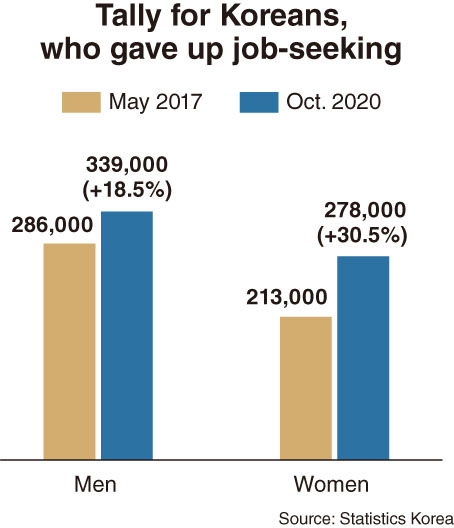[News Focus] Female discouraged workers up 30% since 2017
In 3 years, 97% surge seen in recipients of unemployment benefits among 20-somethings
By Kim Yon-sePublished : Nov. 22, 2020 - 14:55

SEJONG -- South Korea saw its number of people aged 15 or over who have abandoned looking for jobs increase sharply over the past three years, data from a government agency showed.
The data also suggested that women far outstripped men in this category during the first 41 months of President Moon Jae-in’s 60-month term.
According to figures held by Statistics Korea, the number of discouraged workers was 498,000 in May 2017, when the Moon administration took office.
The monthly figure, was usually above 500,000 in 2018 and 2019, and rose to 617,000 in October 2020, marking a 23.8 percent increase (or 119,000) under the incumbent administration.
The tally counts people who had looked unsuccessfully for a job in the previous year but not in the month immediately preceding the survey.

By gender, a 30.5 percent (65,000) increase was reported among women, while the growth for men stood at 18.5 percent (53,000).
The 2020 situation has been much affected by the novel coronavirus. Nevertheless, similar state figures on employment or unemployment for the past three years indicate that there was little apparent improvement in the hiring index, despite a series of extra budget allocations and cash support for young job seekers.
While the nation’s employment rate was 61.5 percent in May 2017, the figure de facto unchanged to 61.3 in May 2018 and 61.5 percent in May 2019. It had recovered slightly to 60.4 percent in October 2020 after sliding to 59.4 percent in April 2020.
In May 2017, when President Moon pledged to actively increase jobs for the young generation particularly, the de facto jobless rate among those aged between 15-29 was 22.9 percent, according to the Supplementary Index III for Employment compiled by Statistics Korea.
Index III provides a relatively new method of calculating unemployment, counting underemployed people among the de facto unemployed. This category, also called “extended-based” jobless, includes those who work fewer than 36 hours a week and want to work more, as well as seasonal workers who are out of work for part of the year.
The de facto jobless rate rose to 23.2 percent in May 2018, to 24.2 percent in May 2019, and to 26.3 percent in May 2020. It had eased to 24.4 percent in October.
This indicates that 1.16 million of the 4.77 economically active people aged 15-29 were unemployed or underemployed as of last month.
This is contrasts with the youth jobless rate, 8.3 percent in October -- the government’s official figure, calculated and publicized in a conservative manner. Under the government’s calculation, the tally for youth jobless was only 341,000.
According to the Korea Employment Information Service, the number of recipients of unemployment payouts among those 20-29 came to 105,496 in September. This posted a 97.6 percent surge from 53,369, posted in May 2017.
Over the corresponding period, total monthly benefits paid to people in their 20s increased from 62.7 billion won ($56.1 million) to 169.3 billion won.
For the entire age bracket, the tally for recipients and benefit payments climbed from 451,773 and 485.9 billion won in May 2017 to 704,729 and 1.19 trillion won in September 2020, respectively.
By Kim Yon-se (kys@heraldcorp.com)







![[From the Scene] Monks, Buddhists hail return of remains of Buddhas](http://res.heraldm.com/phpwas/restmb_idxmake.php?idx=644&simg=/content/image/2024/04/19/20240419050617_0.jpg&u=20240419175937)







![[From the Scene] Monks, Buddhists hail return of remains of Buddhas](http://res.heraldm.com/phpwas/restmb_idxmake.php?idx=652&simg=/content/image/2024/04/19/20240419050617_0.jpg&u=20240419175937)

![[KH Explains] Hyundai's full hybrid edge to pay off amid slow transition to pure EVs](http://res.heraldm.com/phpwas/restmb_idxmake.php?idx=652&simg=/content/image/2024/04/18/20240418050645_0.jpg&u=20240419100350)

![[Today’s K-pop] Illit drops debut single remix](http://res.heraldm.com/phpwas/restmb_idxmake.php?idx=642&simg=/content/image/2024/04/19/20240419050612_0.jpg&u=)